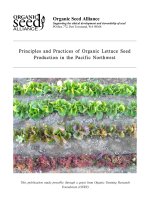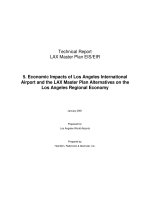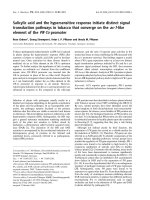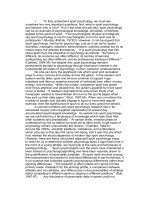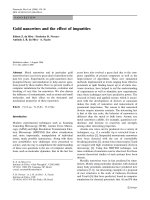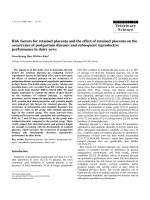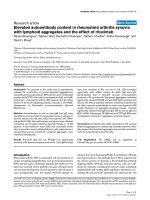Insect pollinators of sesame and the effect of entomophilous pollination on seed production in new alluvial zone of west Bengal
Bạn đang xem bản rút gọn của tài liệu. Xem và tải ngay bản đầy đủ của tài liệu tại đây (475.01 KB, 10 trang )
Int.J.Curr.Microbiol.App.Sci (2019) 8(3): 1400-1409
International Journal of Current Microbiology and Applied Sciences
ISSN: 2319-7706 Volume 8 Number 03 (2019)
Journal homepage:
Original Research Article
/>
Insect Pollinators of Sesame and the Effect of Entomophilous Pollination on
Seed Production in New Alluvial Zone of West Bengal
Rakesh Das* and Shantanu Jha
Department of Agricultural Entomology, Bidhan Chandra KrishiViswavidyalaya
Mohanpur, Nadia, West Bengal, India, PIN- 741252
*Corresponding author
ABSTRACT
Keywords
Sesame, Insect
pollinators,
Abundance, Honey
bees, Yield
Article Info
Accepted:
12 February 2019
Available Online:
10 March 2019
The experiment was conducted at Instructional Farm Jaguli (latitude 23.56° N and
longitude 88.32° E) of Bidhan Chandra Krishi Viswavidyalaya at Mohanpur in Nadia
district of West Bengal during March 2017 to June 2017 to study the diversity and relative
abundance of insect pollinators; and the effect of different modes of pollination on yield
and yield attributing parameters of sesame. A total of 10 insect visitors belonging to order
Hymenoptera (comprising of 5 species viz., Apis dorsata, Apis mellifera, Megachile sp.,
Vespa cincta and Camponotus sericius), Diptera (comprising of 2 species viz.,
Sacrcophaga sp. and Musca domestica) and Lepidoptera (comprising of 3 species viz.,
Danaus chrycippus, Amata bicincta and Pieris sp.) were found to visit the sesame flowers
during the period of study. The abundance (percentage of insect fauna/sq.m/2 min.) of
Hymenopterans (89.87 %) was maximum followed by the Dipterans (6.74 %) and
Lepidoptera (3.37 %). Among them Apis dorsata was the most predominant (76.39 %)
followed by Apis mellifera (7.58 %). Open pollination and honey bee pollination
significantly increased the number of capsules/plant, number of seeds/capsule, 1000 seed
weight and seed yield of sesame as compared to plots without any pollinators. The seed
yield in open condition was significantly higher as compared to honey bee pollination. An
increase in seed yield of 49.92 % and 35.23 % were reported in open and honey bee
pollination respectively as compared to pollinators excluded condition.
Introduction
Pollination is an important step in the seeds
production of all spermatophytes (seed plants),
resulting in the production of offspring that
are genetically diverse (Dafni et al., 2005).
The well-established association between
insects and flowers make them one of the
major groups of pollinating agents. Of the
total pollination activities, over 80% is
performed by insects and among them bees
are considered as the best pollinators
(Robinson and Morse, 1989). It is reported
that one third of the total human food supply
relies on insect pollination (Jivan, 2013; Said
et al., 2015). The major pollinating insects of
different crops mainly belong to the orders
Hymenoptera,
Diptera,
Coleoptera,
1400
Int.J.Curr.Microbiol.App.Sci (2019) 8(3): 1400-1409
Lepidoptera, Thysanoptera, Hemiptera and
Neuroptera (Free, 1993; Kearns et al., 1998;
Mitra and Parui, 2002; Mitra et al., 2008).
In India sesame (Sesamumindicum L.) ranks
third after Groundnut and Mustard among the
major nine oil seed crops. The flower structure
of sesamum facilitates cross pollination, even
though the crop is usually considered as selfpollinating (Yermanos, 1980; Ashri, 2007 and
Sarker, 2004). The range of cross-pollination
varies in between 0.5% to 65% depending
upon insect activity, environmental conditions
and availability of other vegetation (Kumar
and Lenin, 2000).
Though most of the oil seed crops are cross
pollinated still adequate pollination is vital for
significant increase in seed production
especially by the utilization of honeybee as
effective pollinators. Both in open pollination
and bee pollination treatments the seed yield
of sesame can be increased up to22 to 33 % or
more than that of pollinators excluded
condition (Panda et al., 1988). In addition to
yield increase, cross-pollination also helps to
improve the seed quality through a more
unified ripening period and an earlier
harvesting time.
By keeping this view in mind the present
study was carried out to identify the insects
associated with sesame crop during the critical
period (flowering phase) in New Alluvial zone
of West Bengal and also the impact of
pollinators on seed set of sesame crop was
assessed.
The location of the farm is latitude 23.56° N
and longitude 88.32° E. The average elevation
above the Mean Sea Level (MSL) of the
experimental farm is about 9.75 meters.
Experimental design
The experimental plot was designed in three
large plots measuring 12x6 m each. Then
seven small plots measuring 1 m2 (1m x 1m)
were selected randomly from each of the large
plots, representing replications. The seeds
were sown in continuous with row to row
spacing of 30 cm on 15th March, 2017 on
each field. Later excess plants were removed
to obtain uniform crop stand. All the
recommended package of practices was
followed for raising a healthy crop.
Diversity of insect pollinators visiting
sesame flowers
The insect species visiting sesame flowers
were inspected once in a week from 7.00 am
to 5.00 pm. The foraging insects were
collected by using hand net and sweeping was
done at two hours interval throughout the
blooming period of the crop starting from 510% flowering. The collected insects were
killed and were subsequently identified by
using the literatures available.
Relative abundance of insect pollinators on
sesame flowers
Experimental Location
The number of insect visitors per square meter
area of crop per 2 minutes was recorded from
seven randomly selected prescribed areas at
around 11 am from which the relative
abundance of these insect visitors were
calculated by using the formula:
The experiment was conducted during March
2017 to June 2017 at Instructional Farm Jaguli
of Bidhan Chandra Krishi Viswavidyalaya at
Mohanpur in Nadia district of West Bengal.
Relative abundance (%) = (Population of a
particular species visiting flowers/ Total
population of all species visiting flowers) x
100
Materials and Methods
1401
Int.J.Curr.Microbiol.App.Sci (2019) 8(3): 1400-1409
These observations were started when about 510% of the plants came into bloom and were
recorded throughout blooming period of the
crop, once every week.
Effect of honey bee (Apis mellifera)
pollination on yield attributing parameters
and yield of sesame
For this experiment three large plots
measuring 12X6 m each were allotted for each
treatment. The three treatments were: T1 –
Plants with open pollination (Fig. 1); T2 –
Plants caged with net having only honey bee
(Apis mellifera) inside the net as pollinators
(Fig. 2); T3 – pollinators excluded (without
any pollinators) (Fig. 3). In T1, the plants
were kept open and allowed all the pollinators
to visit the flowers. In T2, the entire plot was
covered by a large net measuring 12m x 6m x
4m and one 4-frames colony of Apis mellifera
in a Nucleus hive was placed inside the net at
a height above the crop canopy when about 5 10% of flowers have come into bloom. In T3,
plants were covered with nets (1m x 1m x 1m
size) but no hive was placed inside the nets.
When the flowering was completed and
capsule formation started, the nets and honey
bee colonies were removed from the plots.
After maturity, plants from each treatment
were harvested and sun dried. Observations
were taken on, number of capsules/plant;
number of seeds/capsule; 1000 seeds weight
(g) and seed yield (kg/ha).
To record the mean number of capsules/plant,
10 plants from each replication were selected
randomly. To work out the number of seeds/
capsule, 10 randomly selected capsules from
these plants under each of the replications was
counted and the mean number (per 10
capsules) was worked out for every
replication. The seeds from these capsules
were collected to take weight of 1000 seeds
weight. The seed yield obtained from each of
the replications was later converted into kg/ha.
An increase in seed yield due to open
pollination and managed honey bee
pollination over pollinators excluded was
calculated by using the following formulaYield increment (%) = (Yield of honey bee or
open pollinated crop –Yield of plot without
pollinator) / Yield of plot without pollinator X
100
Results and Discussion
Diversity of insect pollinators visiting
sesame flowers
The insect species visiting the field of sesame
during flowering period of the crop were
collected and identified by using available
literature and listed in Table 1 along with their
systematic position.
Data presented in Table 1 showed that a total
number of ten insects belonging to the order of
Hymenoptera, Diptera and Lepidoptera were
found to visit the flowers of sesame. Among
them Hymenopteran insects were predominant
comprising of five species from four different
families namely Apidae, Megachilidae,
Vespidae and Formicidae. The former family
(Apidae) consists of two species of honey bees
namely, rock bee, Apis dorsata and Itallian
bee, Apis mellifera. However, the rest three
families were represented eachby single
species of insect visitors namely, leaf cutter
bee, Megachile sp. (Megachilidae), wasp,
Vespa cincta (Vespidae) and ant, Camponotus
sericius (Formicidae). On the contrarythree
families under the order Lepidoptera and two
families under Diptera were recorded during
the study. Lepidopteran insects fauna from
three families were monarch butterfly, Danaus
chrycippus (Nymphalidae), pierid butterfly,
Pieris sp. (Pieridae) and amata moth (Amata
bicincta) Whereas, flesh fly, Sarcophaga sp.
(Sarcophagidae) and common house fly,
1402
Int.J.Curr.Microbiol.App.Sci (2019) 8(3): 1400-1409
Musca domestica (Muscidae) represented
Diptera.
The present findings are in line with the
findings of Sanganna et al., (2015) who
reported that a total of 14 insect species visited
the sesame flower, out of 14 insect species,
10spp. belong to Hymenoptera and 4 to
Diptera. Among Hymenopterans, the 4 spp. of
honey bees were recorded during flowering
period. The present findings are also
corroborated by those of Mahfouz et al.,
(2012), who reported four groups of
pollinators visiting sesame belonging to orders
Hymenoptera, Diptera, Lepidoptera and
Coleoptera during the flowering period and
the number of Hymenoptera was highest,
followed by Lepidoptera, and then both of
Coleoptera and Diptera. In another study
Kamel et al., (2013)reported 29 insect species
belonging to four groups, 18 of which
belonged to Hymenoptera, 7 to Diptera, 3 to
Lepidoptera and 1 to Coleoptera during the
blooming periodof sesame. These findings are
in close agreement with Viraktmath et al.,
(2001) who studied the relative abundance of
pollinator fauna of sesame during two
successive seasons. 29 insect species recorded,
15 belonged to Hymenoptera, 8 to Diptera and
6 to Lepidoptera.
Relative abundance of pollinators
Relative abundance of pollinators per sq.m
was recorded on sesame flowers at seven days
interval during April and May, 2017 following
the methods mentioned earlier. The number of
pollinators recorded per sq.m of sesame field
is presented in Table 2 and the diagram is
shown in Figure 4. On the basis of insect
pollinators recorded per square meter during
the entire flowering period, Apis dorsata was
the most predominant species with an average
population of 2.53 insects per sq.m
representing 76.39% of total insect visitors.
This was followed by Apis mellifera, the
second dominant insect visitor with an average
of 0.25 insects per sq.m constituting 7.58% of
insect fauna. The leaf cutter bee, Megachile
sp. and Amata bicincta occupying 5.90% and
3.37% population of insect visitors with an
average of 0.19 and 0.11 insects per sq.m
respectively. The dipteran flies in totality were
represented by 6.74% of insect fauna with an
average population of 0.22 insects per sq.m.
Whereas other insects were occasionally seen
to visit the flowers.
It was further observed that, the pollinator
population increased with flowering and after
reaching a peak period it gradually declined
(Fig. 5). The peak population (4.83 insects per
sq.m) was observed on 6th May, 2017during
peak period of flowering.
Later it declined with the decline in number of
flowers and capsule development. The average
number of insects per sq.m during the
flowering period was 3.19.
Similar results were documented by Kamel et
al., (2013)where it had been shown that the
percentage of Hymenoptera was higher in both
the seasons of study and it were 90.94% and
89.59%, sequentially which were followed by
Diptera (3.93% and 5.38%), Lepidoptera
(3.58% and 3.62), and Coleoptera (1.53% and
1.39%)during the entire blooming period of
sesame.
Effect of honey bee pollination on yield and
yield attributing parameters
Under field condition the effect of honey bee
pollination on seed yield and yield attributing
parameters of sesame was studied in
comparison with open pollination and
pollinator
excluded.
Following
yield
attributing parameters were recorded during
the course of study:
Number of capsules /plant
Number of seeds /capsule
1403
Int.J.Curr.Microbiol.App.Sci (2019) 8(3): 1400-1409
1000 seed weight (gm.)
From these parameters the seed yield (kg/ha)
was calculated. Furthermore an increase in %
seed yield in open and honey bee pollination
over pollinator excluded crop had been
calculated. The findings are represented in the
Table 3.
The average number of capsules per plant was
found to be highest (41.57 capsules/plant) in
open pollination followed by honey bee (A.
mellifera) pollination (38.85 capsules /plant).
On the contrary, it was only 28.71
capsules/plant in pollinators excluded. It was
further observed that open pollinated and
honey bee (A. mellifera) pollinated plot
showed significant difference in respect of
average no. of capsules/plant.
The data recorded on mean number of seeds
per capsule revealed that mean number of
seeds per capsule (50.85 seeds/capsule) was
higher in open pollinated plot followed by plot
caged with A. mellifera colony (49.14
seeds/capsule) and the least number of seeds
per capsule (38.14 seeds/capsule) was
recorded in pollinators excluded. It was also
observed that open pollinated and honey bee
(A. mellifera) pollinated plot showed no
significant difference i.e., these treatments
were statistically at par.
The highest mean 1000 seed weight was
recorded in open pollinated (3.10gm) plot
followed by A. mellifera (2.89gm), whereas
the lowest mean 1000 seed weight was
recorded in pollinators excluded (2.56 gm).
Significant difference was also observed
between open and honey bee pollinated plot.
The impact of different modes of
entomophilous pollination showed that highest
seed yield was obtained in open pollinated
(835.14 kg/ha) plot followed by A. mellifera
(784.71 kg/ha) pollination. However, the
lowest yield among the treatments was
obtained from pollinators excluded plot
(580.28 kg/ha). The above data revealed that
open and honey bee (A. mellifera) pollination
showed clear increment in seed yield in
comparison to pollinators excluded. The
percentage yield increase of the former two
treatments was calculated over pollinators
excluded condition following the method
discussed earlier. The highest percentage yield
increase was observed in open pollination
(43.92%) followed by A. mellifera (35.23%)
pollination.
The answer behind the effect of better result in
open pollination over A. mellifera pollination
may lie in the fact that in open condition the
flowers were visited by composite natural
pollinators, whereas in net pollinated
condition only A. mellifera visited the flowers
as pollinator. As well as the number of total
pollinators in open condition was found higher
than the net pollinated condition throughout
the study period (Table 4). Hence the spatiotemporal variation of different pollinators
attend better pollination of flowers in open
condition over net pollinated, leads to better
result in open condition.
The results of present investigation are in
conformity with the earlier recorded
observations of Mahmoud (2012)who reported
that sesame plants exposed to insects visit had
significantly higher quantity and quality yield
compared to plants from which insects were
excluded during course of study. Similar
observations were also recorded by Rahman
(2014) who studied the impact of different
modes of pollination in sesame and reported
that both open and caged pollination with
honey bee significantly increased the no. of
capsule per plant, no. of seeds per capsule and
thousand seed weight (g) as compared to
pollinators excluded condition and the highest
yield was obtained in caged with honey bee
pollination (1.16 t/ha) followed by open
1404
Int.J.Curr.Microbiol.App.Sci (2019) 8(3): 1400-1409
pollination (1.03 t/ha) with no significant
difference. In an another study Panda et al.,
(1988) reported that both in open pollination
and bee pollination treatments the seed yield
of sesame can be increased upto 22 to 33 % or
more than that of pollinators excluded
condition.
Table.1 List of different insects visiting sesame flowers during study
Sl.
No.
1.
2.
3.
4.
5.
6.
7.
8.
9.
10.
Common name
Scientific name
Rock bee
Itallian bee
Leaf cutter bee
Wasp
Ant
Apis dorsata
Apis mellifera
Megachile sp.
Vespa cincta
Camponotus
sericius
Monarch butterfly
Danaus chrycippus
Pierid butterfly
Pieris sp.
Amata
moth/nine Amatabicincta
spotted moth
Flesh fly
Sarcophaga sp.
Common House fly
Musca domestica
Family
Order
Apidae
Apidae
Megachilidae
Vespidae
Formicidae
Hymenoptera
Hymenoptera
Hymenoptera
Hymenoptera
Hymenoptera
Nymphalidae
Pieridae
Arctiidae
Lepidoptera
Lepidoptera
Lepidoptera
Sarcophagidae
Muscidae
Diptera
Diptera
Table.2 Observations for abundance of different pollinators persq.m in sesame
Date
22.4.17
29.4.17 6.5.17 13.5.17
20.5.17
Total
Average
A.dorsata
A. mellifera
Megachilesp.
Dipteran flies
Amatabicincta
Total
1.42
0.14
0.00
0.28
0.00
1.84
3.71
0.28
0.28
0.14
0.14
4.55
1.28
0.28
0.14
0.14
0.28
2.12
12.69
1.26
0.98
1.12
0.56
16.61
2.53
0.25
0.19
0.22
0.11
3.57
0.42
0.42
0.28
0.14
4.83
2.71
0.14
0.14
0.28
0.00
3.27
Mean
population
76.39
7.58
5.90
6.74
3.37
%
Table.3 Change in yield through honey bees and open pollination
Open
pollination
nation
Honey
bee
(A.
mellifera) pollination
Without
any
pollinator
SE(m)
CD at 5%
Number
of
capsules/plant
41.57
(6.52)*
38.85
(6.31)*
28.71
(5.44)*
0.041
0.129
Number of
seeds/capsule
50.85
(7.20)*
49.14
(7.08)*
38.14
(6.25)*
0.038
0.119
*Square root transformed values in parenthesis
1405
1000 Seed
Wt.(gm.)
3.10
(2.02)*
2.89
(1.97)*
2.56
(1.88)*
0.008
0.024
Projected Seed % increase in
Yield(kg/ha)
yield
835.14
43.92
784.71
580.28
0.006
0.017
35.23
Int.J.Curr.Microbiol.App.Sci (2019) 8(3): 1400-1409
Table.4 Population of insect fauna in open and honey bee (A. mellifera) pollination
Date
A. dorsata
22.04.17
29.04.17
06.05.17
13.05.17
20.05.17
1.42
3.71
3.57
2.71
1.28
A.
mellifera
0.14
0.28
0.42
0.14
0.28
Megachile
sp.
0.00
0.28
0.42
0.14
0.14
Others Total
outside net
0.28
1.84
0.28
4.55
0.42
4.83
0.28
3.27
0.42
2.12
Fig.1&2 Open pollination & Honey bee (A. mellifera) pollination
Fig.3 pollinators excluded (without any pollinators)
1406
A. mellifera
in net
2.14
3.21
3.57
2.12
1.42
Int.J.Curr.Microbiol.App.Sci (2019) 8(3): 1400-1409
Fig.4 Abundance of insect pollinators (percentage of insect fauna/ sq.m/2 min.)
3.3
7%
76.39%
Fig.5 Population of different pollinators during different date of observations
In conclusion, the present investigation
showed that a total number of thirteen insect
species from three different orders viz.
Hymenoptera, Diptera and Lepidoptera found
to visit the sesame flowers. Hymenopterans
pollinators (89.87%) were dominant amongst
various pollinators and A. dorsata and A.
mellifera being dominant. Whereas, Dipteran
pollinators (6.74%) were the second dominant
followed by Lepidoptera (3.37%) during the
blooming period of the crop. Both in open
pollination and honey bee pollination the
number of capsules/plant, number of
seeds/capsule, 1000 seed weight and seed
yield of sesame significantly increased as
compared to plots without any pollinators.
1407
Int.J.Curr.Microbiol.App.Sci (2019) 8(3): 1400-1409
The highest seed yield was obtained in open
pollinated (835.14 kg/ha) plot and the lowest
one was observed in pollinators excluded plot
(580.28 kg/ha).The percentage yield increase
over pollinators excluded were43.92% and
35.23% inopen and A. mellifera pollination
respectively.
Acknowledgement
The authors sincerely acknowledge to AICRP
(Honey Bees and Pollinators) for providing
financial and technical facilities to carry out
the present investigation.
References
Ashri, A. 2007. Sesame (Sesamumindicum
L.).
In:
Genetic
Ressources,
Chromosome Engineering and Crop
Improvement, Singh, R.J. (Ed.). Vol. 4.
Oilseed crops. CRC Press, Boc Raton,
FL., pp. 231- 289.
Dafni, A. and Kevan, P.G. 2005. Practical
pollination biology. Enviroquest, 20:
114- 128.
Free, J.B. 1993. Insect Pollination of Crops.
Academic Press. London UK, pp. 684.
Jivan, A. 2013. The Impact of Pesticides on
Honey Bees and Hence on Humans.
Scientific Papers Animal Science and
Biotechnologies 46(2): 272-277.
Kamel, S.M., Blal, A.H., Mahfouz, H.M. and
Said, M. 2013.The most common insect
pollinator species on sesame crop
(Sesamum indicum L.) in Ismailia
Governorate, Egypt. Arthropods, 2(2):
66-74.
Kearns, C.A., Inouye, D.W. and Waser, N.M.
1998.Endangered
mutualism:
The
conservation of plant pollinator
interactions. Ann. Rev. Eco. Evo.
Syste., 29: 83-112.
Kumar, R. and Lenin, J.K. 2000. Insect
pollinators and effects of cross
pollination on yield attributes of sesame
(Sesamum indicum L.). Indian Bee
Journal, 62 (1-2): 75-80.
Mahfouz, H.M., Kamel, S.M., Belal, A.H. and
Said, M. 2012. Pollinators visiting
sesame (Sesamum indicum L.) seed crop
with reference to foraging activity of
some
bee
species.
Cercetări
Agronomiceîn Moldova, 45(2):150.
Mahmoud, F.M. 2012. Insects Associated
with Sesame (Sesamun indicum L.) and
the Impact of Insect Pollinators on Crop
Production.
Pestic.
Phytomed.
(Belgrade), 27(2): 117–129.
Mitra, B., Banerjee, D., Mukherjee, M.,
Bhattacharya, K. and Parui, P. 2008.
Flower visiting flies (Diptera: Insecta)
of Kolkata and Surroundings, (Pictorial
handbook). India: Zoological Survey of
India (ZSI), Kolkata.
Mitra, B. and Parui, P. 2002. New record of
entomofauna from Thar Desert. Insect
Environ., 8: 115-116.
Panda, P., Sontakke, B.K. and Sarangi, P.K.
1988.Preliminary studies on the effect
of bee (Apis ceranaindica Fab.)
pollination on yield ofsesamum and
niger. Indian Bee Journal, 50: 63-64.
Rahman, Z. 2014. Effect of bee pollination on
the yield of sesame (Sesamum indicum
L.). M. Sc. Thesis, Sher-e-Bangla
Agricultural
University,
Dhaka,
Bangladesh.
Robinson, W.E. and Morse, R.A. 1989. The
value of honeybees as pollinators of US
crops. American Bee Journal, 129(1):
477-487.
Said, F., Inayatullah, M., Ahmad, S., Iqbal,
T., and Shah, R. A. 2015. Foraging
behavior of the Himalayan Honeybee,
Apis cerana (Hymenoptera: Apidae)
associated with sunflower (Helianthus
annuus L.) at Peshawar District of
Khyber Pakhtunkhwa (KP). Journal of
Entomology and Zoology Studies 3(3):
203-207.
Sanganna, M.S. and Eswarappa, G. 2015.
1408
Int.J.Curr.Microbiol.App.Sci (2019) 8(3): 1400-1409
Sesame (Sesamum indicum L.) Crop
Insect
Pollinators
with
Special
Reference to the Foraging Activity of
Different Species of Honeybees. IOSR
Journal of Agriculture and Veterinary
Science (IOSR-JAVS), 8(11): 09-14
Sarker, A.M. 2004.Effect of honeybee
pollinisation on the yield of rapeseed,
mustard and sesame. Geobros (jodhpur),
31: 49-51.
Viraktmath, S.A., Patil, B., Murasing, S. and
Guruprasad, G.S. 2001. Relative
abundance of pollinator fauna of cross
pollinated oilseed crops at Dharwad in
Karnataka (India). Indian Bee Journal,
63(3-4): 64-67.
Yermanos,
D.M.
1980.Sesame.
In:
Hybridization of Crop Plants, Fehr, H.
and H. Hadleys (Eds.). Agronomy-crop
Science Society of America, Madison,
WI., pp. 549-563.
How to cite this article:
Rakesh Das and Shantanu Jha. 2019. Insect Pollinators of Sesame and the Effect of
Entomophilous Pollination on Seed Production in New Alluvial Zone of West Bengal.
Int.J.Curr.Microbiol.App.Sci. 8(03): 1400-1409. doi: />
1409

